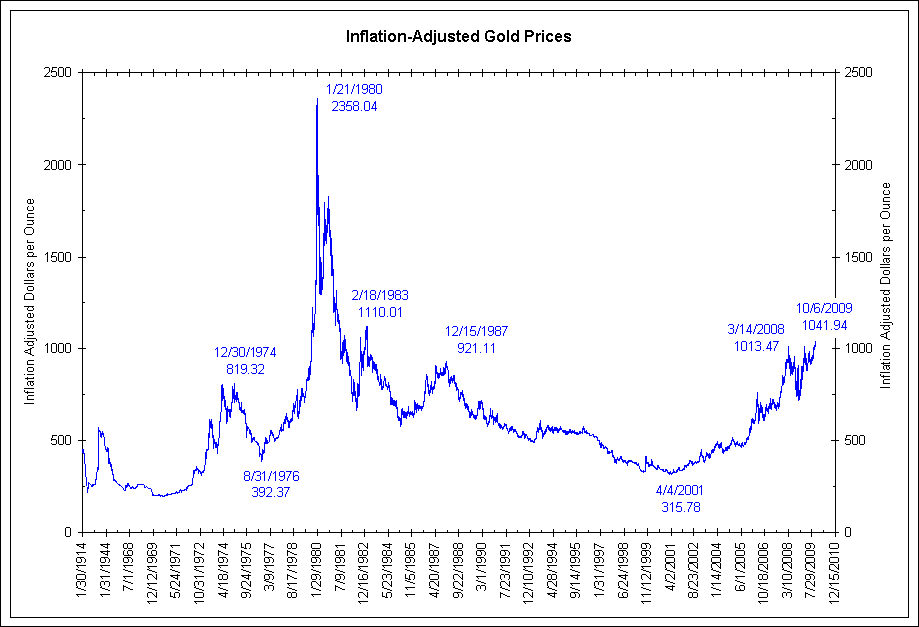Hey Gerry. You wanted some rational? Here's some rational.
I got a little excited when the discussion document started talking about rare earth elements like dysprosium, terbium, erbium, ytterbium and unobtainium, but let's look at the actual "mineral wealth" in the conservation areas they want to open up:
Paparoa: Coal, gemstones, gold
Coromandel: Gold-silver, peat
Great Barrier Island: Gold-silver
Otahu: Gold-silver
Parakawai: Gold-silver
GERRY WANTS GOLD.
The problem is that all the reports estimate the value of gold reserves based on current prices. Why is this a problem? Because the real price of gold is currently hovering around a 27-year high (courtesy of The Big Picture):
Gold price tends to spike during times of economic (especially financial) uncertainty. Oh hey, that's us! When the boom times come back, gold prices come back down. So basically, we're digging for stuff that'll almost certainly be worth less by the time it comes out of the ground. (Not worthless, of course, just worth less.)
–
And Gerry pulled out this line again (his stock line when talking about mining):
It's also worth noting that in productivity terms, workers in the mining sector return an average of $360,000 of GDP per worker, nearly six times the national average."
Wow, $360,000, that's *heaps*! If we were all miners, we'd all be rich!
No.
Here's what Gerry did. He took the total worth of the mining sector, then divide it by the number of people it employed. It does not mean that more mining = higher productivity. It just means that mining is very capital-intensive and employs relatively few people, which are fairly obvious facts.
The median income for wage and salary earners in mining in 2008 is actually $57,660.
The "output per worker" ("$360,000") is very high because most of the output comes from a) large expensive machines produced by other countries and b) the ground. The worker is not a highly valuable nor highly valued part of the process.
Sure, mining could become a cash-cow for the government, but the kind of “productivity” that Brownlee's talking about does not lead to improved quality of life for New Zealanders. (Unless you're a New Zealander who owns a mining company.)
To be fair, from what I can tell, 80% of mining firms are majority NZ-owned. That's not to say that new entrants into the market will also be NZ-owned, but the characterisation of mining companies as evil multinationals is unfounded. If they are evil, they're locally-owned evil.
–
This just seems like such a giant leap backwards. We've spent so many years talking about the knowledge economy, moving up the value chain, selling ideas and knowhow rather than soil nutrients... and now the vision for a more productive New Zealand is digging shit up and cashing it in?
We know exactly why we can't rely on the primary sector in the long-term. The more you squeeze out of the land, the harder you need to squeeze to get the next dollar out. It means that growth becomes harder, and we've said for years that moving up the value chain – agriscience, biotech, etc. – was the way forward.
Value-add! Innovation! Selling ideas! This was what “ambitious for New Zealand” was supposed to be about, right?
So what the hell is this?
--
Check out this great piece yesterday by my friend Chye-Ching Huang on the plans for a New Zealand Productivity Council.
--
(Also, using "conservation fund = $2-10m over four years = 50% of royalties" to estimate how much the government stands to gain is deeply unreliable. The $2-10m figure is just an arbitrary cap, and there's nothing to suggest that royalties will *actually* be within this range. My bet is that the revenue impact estimate of mining royalties is currently "mehdunno". OIAing this now...)
